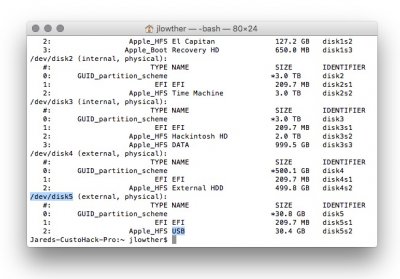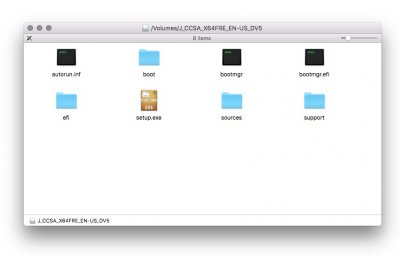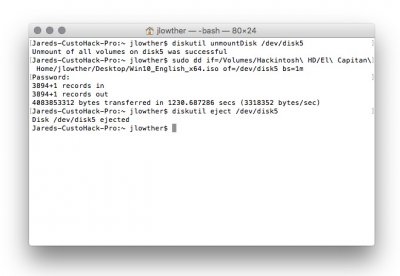- Joined
- Mar 1, 2013
- Messages
- 943
- Motherboard
- GA-Z77X-UD5H
- CPU
- i7-3770K
- Graphics
- 2x GEFORCE GT 640
- Mac
- Mobile Phone
If you dont have access to a Windows machine, you can use terminal to create a Bootable USB
First thing you need is a USB of at least 8 GB, and a Windows 10 ISO image.
Next open and terminal and use
to find the /dev/disk# in my case, for the USB drive it is disk5. For the rest of this guide I have highlighted 5, as this will be a unique number to your specific setup..
First thing you need is a USB of at least 8 GB, and a Windows 10 ISO image.
Next open and terminal and use
Code:
diskutil list
Next you want to unmount that disk by entering
Code:
diskutil unmountDisk /dev/disk[B]5[/B]Next add
Code:
sudo dd if=
Code:
sudo dd if=/Volumes/Hackintosh\ HD/El\ Capitan\ Home/[COLOR=#0000FF]yourusername[/COLOR]/Desktop/Win10_English_x64.isoafter that add a space (If its not already there) and type
Code:
of=/dev/disk[B]5[/B] bs=1m
Code:
sudo dd if=/Volumes/Hackintosh\ HD/El\ Capitan\ Home/[COLOR=#0000FF]yourusername[/COLOR]/Desktop/Win10_English_x64.iso of=/dev/disk[B]5[/B] bs=1mYou need to be patient when I first did this on a USB 2.0 it took 39 minutes. This time because i was curious I used a USB 3.0 and it took 21 minutes
When its finished you will see the bytes transferred, the time it took in seconds, and the bytes/sec.
Finally, you have one more step. In terminal you want to type
Code:
diskutil eject /dev/disk[B]5[/B]This will eject the disk, and you can remove it from the USB port. For verification, I reinserted the USB, opened it up, and this is what you should see

Last edited:

